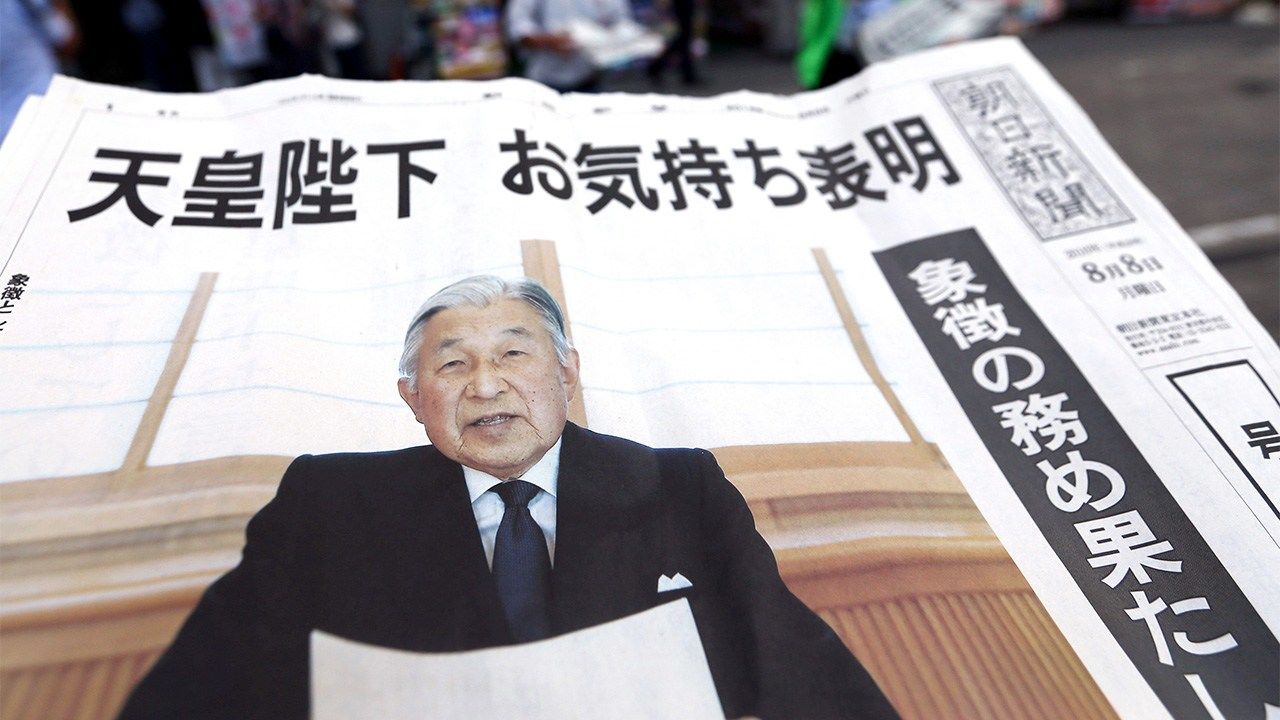
Allowed to Abdicate: The Background to Japan’s Imperial Succession
Society Imperial Family- English
- 日本語
- 简体字
- 繁體字
- Français
- Español
- العربية
- Русский
A Message from the Emperor
The road to Emperor Akihito’s abdication began on July 13, 2016, when the public broadcaster NHK reported that he had expressed a wish to relinquish his position within the next few years. The story was picked up by other media outlets and soon became a general topic of discussion and speculation.
On August 8, Akihito addressed the Japanese people in a video message. Although he stated that “under the Constitution, the Emperor does not have powers related to government,” which meant that he could not directly request a change in the law to make abdication possible, he nonetheless stressed his desire to leave the role.
The emperor was 82 and still performing his official duties, despite having undergone prostate cancer surgery and a heart bypass operation. The main reasons he gave in his address for why he should abdicate in the near future were as follows: His declining fitness might make it difficult to perform his duties with his full strength; the ill health of a serving emperor can bring society to a standstill and impact people’s lives; and if imperial funeral events coincided with the ceremonies that mark the start of a new era, it would place a great strain on surviving family members.
It is worth noting that Emperor Akihito expressed his opposition to the idea of an imperial leader unable to perform his duties of being close to the people and sharing time with them as “the symbol of the State.” The message conveys a strong sense that he did not want to see a regent installed to substitute for the emperor.
Later media reports indicate that Akihito first broached the idea of abdication in 2010. He set 2018, the thirtieth year of his reign, as a personal deadline and waited for an opportunity to make his case. After his video message went public, surveys showed 80%–90% of the population supported allowing him to abdicate.
Public Opinion Pushes Process Along
The government set up a panel headed by Japan Business Federation (Keidanren) Honorary Chairman Imai Takashi to consider the matter. In discussions in November 2016, the 16 specialists called in to comment were broadly split between support for and opposition to abdication.
In January 2017, both houses of the Diet began consideration of necessary legal moves. On March 17, the leaders of the two houses presented Prime Minister Abe Shinzō with a summary of discussions including proposals for special legislation. One of the reasons given in the summary for pressing ahead with establishing legislation for abdication was the public understanding the emperor had won through his 2016 address.
The option to amend the Imperial House Law itself was rejected, as it was felt the Diet should take responsibility for making a decision if a similar situation arises in the future. Special one-off legislation for the present emperor means that abdication formally remains an exceptional event, while at the same time setting a clear precedent for future cases.
The government presented the proposal to the Diet in May 2017; it was enacted into law on June 9.
Imperial Abdication Timeline to Date
| 2016 | July-19 | NHK reports that Emperor Akihito has stated a wish to abdicate. |
| August-19 | Emperor Akihito releases a video message expressing his desire to abdicate. | |
| September-19 | The government establishes a panel to discuss the matter. | |
| October-19 | The panel meets for the first time. | |
| 2017 | March-19 | Leaders of both houses of the Diet present proposed legislation to make abdication possible. |
| April-19 | The panel presents its final report. | |
| May-19 | The cabinet approves special legislation for abdication. | |
| June-19 | The legislation is enacted into law at a plenary meeting of the House of Councillors. | |
| December-19 | A cabinet ordinance sets April 30, 2019, as the date for Emperor Akihito’s abdication. | |
| 2018 | January | The government establishes a panel to prepare for ceremonies relating to the imperial succession. |
| 2019 | February-19 | A ceremony is held to celebrate 30 years of Emperor Akihito’s reign. |
| April-19 | The government announces that Reiwa will be the new era name . |
Debate Over Era Name Announcement Date
In December 2017, the government set the date for abdication as April 30, 2019. After generally smooth progress to this point, the timing for announcement of the new era name became unexpectedly contentious.
Taking into account the necessity to adjust computer systems and the wishes of companies printing calendars and diaries, the government initially considered an announcement in the summer of 2018. This was because the resolution attached to the special legislation stated that the succession should not cause problems for Japanese citizens. However, conservatives declared that this would be an affront to the current emperor. After the first date was discarded, it was expected that the announcement would come in February 2019, when the ceremony to celebrate 30 years of Emperor Akihito’s reign would take place.
Conservatives again objected to early disclosure, on the basis that it went against tradition, as an emperor and his era name were indivisible. After some maneuvering behind the scenes, Prime Minister Abe formally set the date for the announcement on April 1 to allow one month for dealing with the adjustments required to computer systems and other preparations.
(Originally written in Japanese by Ishii Masato of Nippon.com. Banner photo: A newspaper on August 8, 2016, displays headlines about Emperor Akihito’s video message to the Japanese people. © Jiji.)